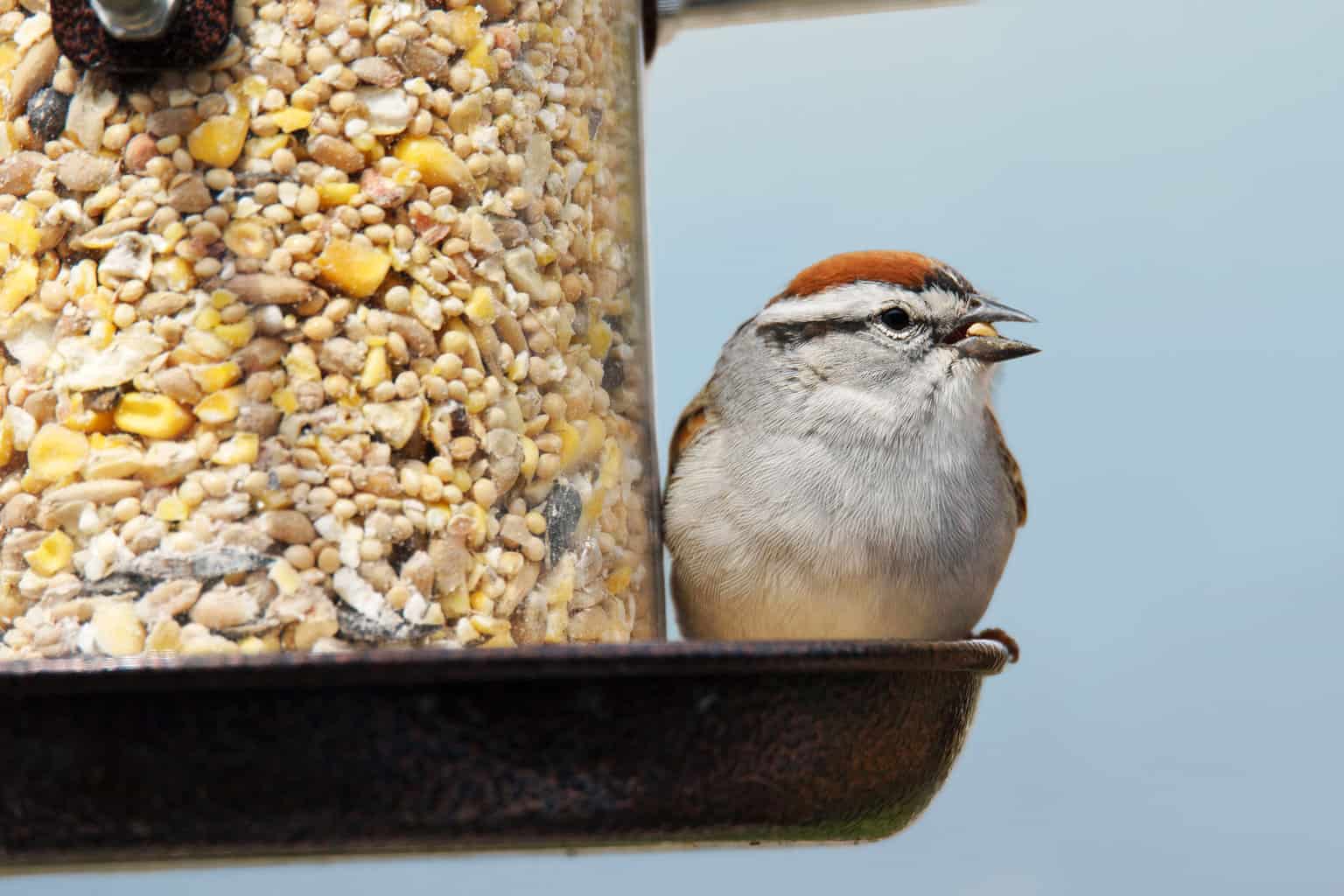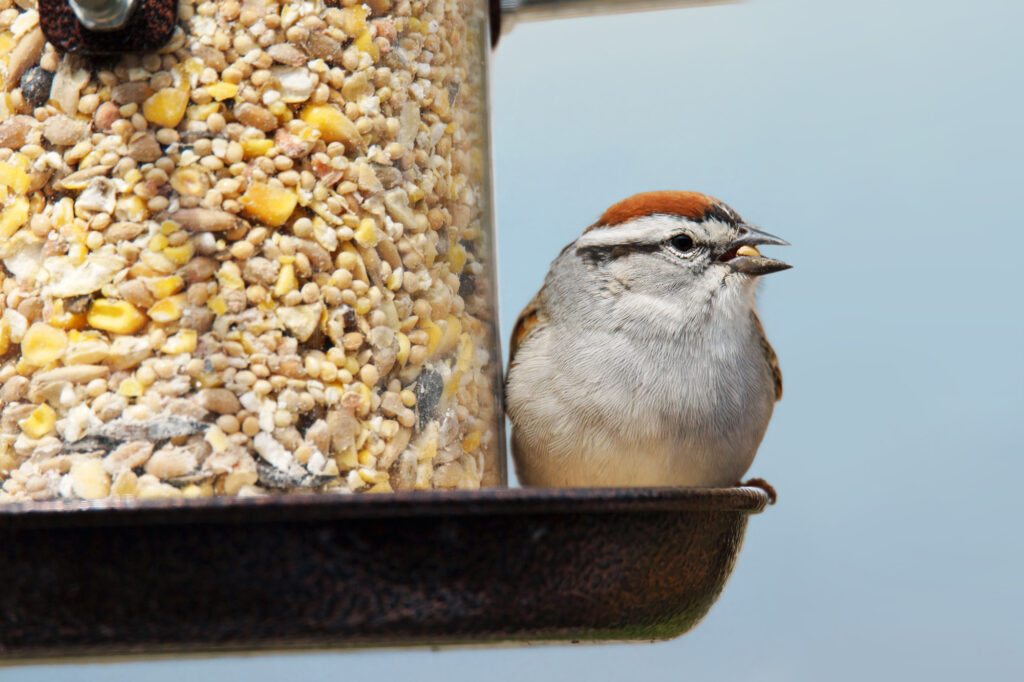When you’re purchasing a bag of mixed birdseed, there are many options to choose from with different ingredients.
When you read over the ingredients list, you will see familiar seeds like sunflower and safflower. However, you will also see others like milo and white proso millet. Do birds like these seeds? Many backyard birds eat millet, but which species? Keep reading to find out!
Types of Millet Seeds
Millet is a type of birdseed that resembles miniature kernels of popcorn! There are three types of millet used in bird seed: white proso millet, golden millet, and red millet. White proso and red millet are the most common, so let’s discuss them in further detail.
White Proso and Red Millet Seed
White proso millet is a high-protein seed that is a favorite food among ground-feeding birds. Doves, juncos, towhees, and sparrows are some of the common birds that prefer millet.
As well, cardinals tend to eat up white proso millet. If you have larger ground birds like quails or pheasants on your property, they will also be interested in this seed.
Most birds typically prefer white proso to red or golden millet, which some people consider to be less desirable filler ingredients.
Blackbirds, house sparrows, and European starlings, who are often undesirable visitors to feeders, also enjoy millet, in addition to their other regular foods.
The birds that eat red millet are similar to those that eat white proso millet, though they’ll likely prefer the latter if given the choice.
Milo
Milo, sometimes also called sorghum, is another common ingredient in birdseed mixes. It’s a type of millet, but it’s one you likely want to avoid.
Milo is included in birdseed mixes because it’s cheap – that’s the bottom line. Large ground birds such as pheasants, quails, and turkeys will eat it, but the average bird watcher isn’t usually prone to feeding such breeds.
When milo is included in a mixed bird seed, it will usually be discarded by most songbirds in favor of other seeds. This can lead to a mess on the ground and wasted, uneaten seeds in your bird feeding station.
However, there are a few birds that do prefer milo. According to the Cornell Lab of Ornithology preference tests, Steller’s jays, curve-billed thrashers, and Gambel’s quails preferred milo to sunflower seeds.
These western United States species aren’t the bird species that most people are feeding, so milo often goes to waste.
If you are feeding these birds and your milo is getting eaten up, the Cornell Lab recommends scattering milo on low-tray feeders or the ground.
However, they warn that it could also be popular with cowbirds, nest parasites, and “bully birds,” species that people generally prefer not to feed.
Other Filler Seeds

There are many types of bird seed for birds, some of which are just filler seeds meant to load a bag and be put on the market at the lowest cost possible.
However, knowing what seeds aren’t appetizing to birds will go a long way to getting the most out of your bird seed.
While cheap wild bird mixes save you money upfront, you might find that you end up spending just as much or even more in the long run since the filler ingredients will end up uneaten.
Here’s a breakdown of some of the filler ingredients you want to avoid in your bird feeding station:
Wheat
Wheat, like some other less desirable seeds in pre-mixed bags, is mostly eaten by doves, pigeons, or other ground birds. When other seeds are available, most other birds will turn to preferred options.
Canary Seed
Canary seed is popular with two types of birds that you might not want to see: cowbirds and house sparrows.
Some people don’t mind feeding every backyard bird that shows up, cowbirds and house sparrows included.
However, those birds will probably eat seeds that other songbirds will eat, so most people usually opt for something a little different that feeds sparrows, cowbirds, and their favorite songbirds.
Canola Seed or Rapeseed
Among the fans of rapeseed and canola seed are two types of fun backyard birds: juncos and finches. However, the top finch feed is undoubtedly thistle (nyjer seed).
If you’re looking to feed finches, including goldfinches, house or purple finches, or pine siskins, it’s wise to opt for thistle instead.
Juncos will eat sunflower chips and have a preference for millet, so if it’s juncos you’re after, you can turn to those options.
Frequently Asked Questions
What kind of millet is best for birds?
When given the choice, birds that eat millet tend to prefer white proso over red or golden millet.
White proso millet is a high-protein food that ground birds, sparrows, cardinals, and juncos enjoy.
Which birds eat millet seed?
Ground birds are among the birds that eat millet. This includes doves, sparrows, pigeons, and quails.
Towhees, juncos, and cardinals are among the popular songbirds that may also eat millet.
Should you buy pre-mixed birdseed?
Pre-mixed birdseed is great when it’s high-quality. When it’s done well, premixed birdseed combines several seed varieties that attract different birds, including finches, cardinals, jays, and more.
However, cheap seed mixes often come with seeds that most birds won’t eat. You’ll save money at first because the seed is cheaper.
However, when you’re cleaning out piles of uneaten filler ingredients to pour in more of the mixture so birds can find their preferred foods, your ‘savings’ goes out the window.
So, if you find that certain seeds, like sunflower and safflower, are the only ones getting eaten, you may be better off just purchasing and filling your bird feeding station with those varieties.
What are the best kinds of seeds?
Which bird seed (or seed mix) you should buy is largely dependent on the type of backyard birds you’re feeding or trying to attract.
Certain birds eat mealworms, fruit, sunflower or safflower seeds, suet, or thistle (nyjer) seed, among a multitude of other options. Do some research on the birds you’re looking to feed and experiment with different seeds to find out what will work for you!
Click here for a full guide to the best bird seeds out there.

